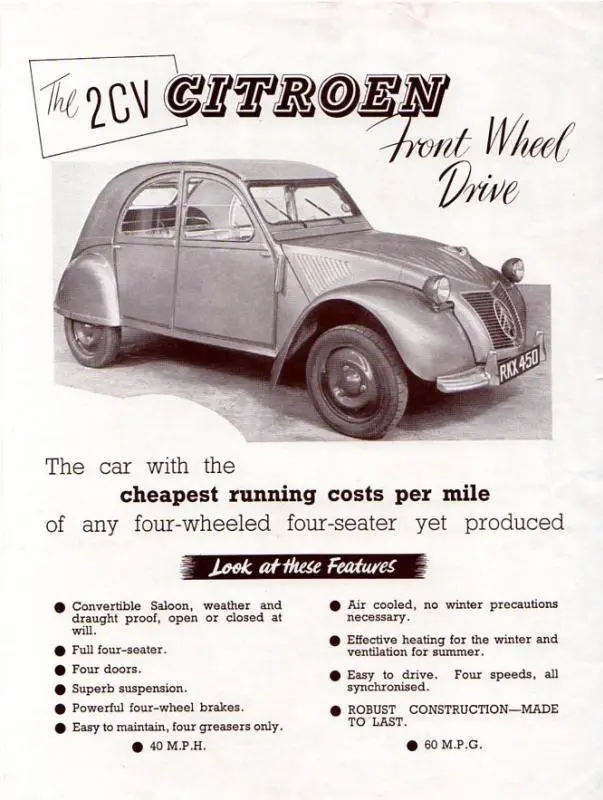70 YEARS OF THE 2CV IN BRITAIN
29 September 2023
the work of a designer who has kissed the lash of austerity with an almost masochistic fervour. Simplified to the point of crudity, it seems almost needlessly ugly, but it is full of original ideals planned to cut weight and cost and increase production. Besides this the Volkswagen is elaborate and the baby Renault a voiture de luxe.
That is how Autocar regarded the new 2CV three-quarters of a century ago when they reported from the 1948 Paris Motor Show. The Deux Chevaux narrative began 12 years earlier, when Citroën’s vice-president Pierre-Jules Boulanger was travelling through the French countryside. A traffic jam of horse and carts inspired him to create the Toute Petite Voiture - TPV - project; a car that would be in financial reach of the average farmer.

TPV’s design criteria were low maintenance costs, room for four adults and 50kg of luggage, plus removable seats. In addition, it would have to be able to safely transport a basket of eggs over a ploughed field. When the 2CV finally made its bow in 1948 its price in UK terms was £213, compared with £284 for the Renault 4CV. The 375cc, flat-twin engine was capable of 60mpg and by the early 1950s, Citroën had a waiting list of several years.
British assembly at the company’s Slough plant did not begin until 1953; until then the government banned vehicles with inboard front brakes. Compared with their French counterparts, the UK-built Deux Chevauxs featured a 12 volt Lucas electrical system, a lockable steel boot lid trafficators, opening rear windows plus a “Front Wheel Drive” badge on the bonnet. One fascinating detail was how the interior light mounted on the top of the windscreen rail doubled as illumination for the speedometer. That same instrument also operated the windscreen wipers.
The Slough 2CV cost £598 7s, and its domestic rivals were the Austin A30, the Ford Anglia 100E, the Morris Minor Series II and the Standard Eight. None could boast a sunroof and the Deux Chevaux even featured a heater, albeit with no demister. Clearing the windshield in poor weather conditions meant opening the front windows and the front ventilator flap.
Autocar of the 22nd January 1954 published an account of an epic journey across the UK in a Slough 2CV. The writer thought a Deux Chevaux driver had to “ work for his living and more or less pump the gear lever like a fireman on an express locomotive shovelling coal”. At the end of the quest, he thought:
At first the contrast with the average car in every single respect, and of course in performance, may prove slightly repellent. But make a journey in the 2CV, sample it for the handy runabout that it is, and you are apt to become a convert”.
However, Motor Sport, while praising the Deux Chevaux, identified its marketing challenges in the UK. Their editor Bill Boddy noted:
As I see it, the British public, always conservative in their tastes, hold the following points against the 2CV:
- They cannot believe that such a small-engined car will be speedy enough for their needs, or comfortably spacious.
- They do not trust a design so outrageously unconventional as to embrace an air-cooled engine, with but two cylinders, and front-wheel drive.
- It is too expensive.
- It is ugly.
“Ugly” is a strong term but to an A30 or Anglia driver, the 2CV represented the outer reaches of bohemianism, together with beards, berets and sandal-wearing. Citroën may have claimed it could “negotiate all European mountain passes without overheating” but this was of little interest to the average East Cheam motorist. By 1959, just 1,036 2CVs had departed the Slough works.
That year saw the final incarnation of the British Deux Chevaux as the Bijou, with a locally designed two-door GRP body. It did not prove a commercial success and production ceased in 1964, two years before Citroën closed their UK assembly plant. As for the standard 2CV, British sales would not re-commence until 1974, in the wake of the OEPC Fuel Crisis. When Motor evaluated the latest Deux Chevaux, they thought:
At £898.56 it is still one of the cheapest models on the British market, We thoroughly enjoyed our reacquaintance with this character car, and expect it to be a great success in their country once again.
And with no reference to “masochistic”, “ugly” or “repellent” either.
